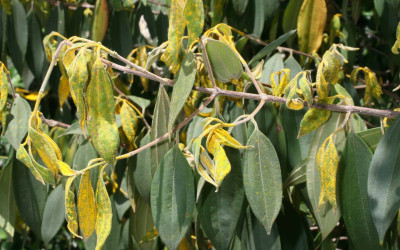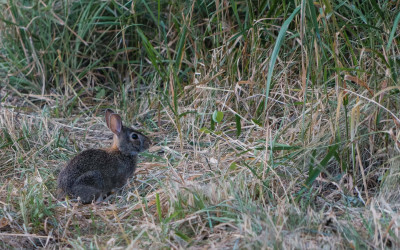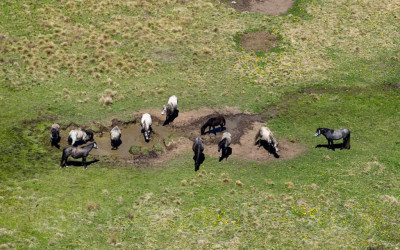MEET THE INVADERS
Goats
Feral goats (Capra hircus) in Australia are mountaineers with a taste for everything.
They descend from a long line of hardy survivors, first domesticated from wild bezoar goats (Capra aegagrus) in the Zagros Mountains of Iran.
Feral goats are highly social and live mobile herds. When water is easy to find, feral goats tend to split into small, scattered groups. But as conditions dry out, those groups start to grow larger. During a drought, they can gather in huge mobs – sometimes 500 to 800 strong!
Goats aren’t picky eaters. While sheep and cattle graze mainly on grasses and flowering plants in the flatlands, goats push into rugged, rocky slopes and feast on anything – wattle and eucalypt leaves, even prickly acacias. They chew bark, and eat bitter and poisonous plants other herbivores won’t touch. When the good stuff’s gone, they just switch their diet.
Goats breed young, all year-round. They can even fall pregnant again while still nursing! One mother can have multiple kids per pregnancy.
In their original homeland, stretching from Turkey to Pakistan, goats had to watch their backs. Wolves, leopards, lions and people kept numbers in check.
Invasion story
Goats were among the first livestock introduced to Australia, with 19 arriving with the First Fleet in 1788. In early colonial times, dairy goats were imported and taken inland to supply settlers, miners and railway workers with milk and meat. Angora and cashmere goats were brought from Asia in the mid-1800s to start a fibre industry, and African Boer goats were imported by farmers in the 1980s for meat production.
It didn’t take long for things to spiral.
As great escape artists, goats often jump or climb fences. Many were kept in a semi-feral state or deliberately released when farming ventures failed. Others were introduced to islands as a food source for shipwrecked sailors – a practice that had devastating consequences.
Lady Elliot Island in the southern Great Barrier Reef is one infamous example. In the late 1800s, the island was stripped bare by guano miners. But when mining ceased, goats were left behind by the Queensland government to provide emergency rations for castaways. Over time, their relentless grazing prevented regrowth and by the mid-20th century, the island had been reduced to a field of compacted coral rubble. It took decades of revegetation efforts to undo the damage.
In more recent times, goats used as biological control for weeds in New South Wales and Queensland have also escaped.
Today, feral goats roam across every state and territory.
They are most common in the arid and semi-arid zones of Queensland, New South Wales, South Australia and Western Australia but are absent or far less common where water is scarce and where dingoes are plentiful.
In addition to the Great Barrier Reef, they’ve also colonised at least 38 offshore islands larger than 20 hectares.
Thankfully, over 60 Australian islands have already been cleared of goats. Kangaroo Island, Bernier Island and Dirk Hartog Island are success stories, with goat removals allowing native species to recover. Eradications from other islands, peninsulas and fenced landscapes where reinvasion is unlikely are more success stories waiting to happen.
Although, despite decades of management efforts, their range on the mainland is still growing.
Their ability to adapt and thrive in harsh landscapes – and to climb and browse terrain that other livestock avoid – has helped them expand across an estimated 2 million square kilometres of the country.
Hardy African Boer goats have also recently interbred with feral populations, creating larger, more adaptable and genetically diverse feral goats.
How did we get here?
Feral goats were formally recognised as a major environmental threat in 1994, when they were listed as a ‘Key Threatening Process’ under national environmental law. The listing led to a national threat abatement plans in 1998 and again in 2008.
But progress was slow. A government review in 2013 found the 2008 plan had failed to reduce impacts. Feral goat numbers had been rising for 2 decades and were continuing to do so. Long-term funding for control was scarce, even in areas of high biodiversity value. A new plan was drafted in 2023, but the damage already done is extensive and ongoing.
Part of the problem has long been commercial incentives, viewing wild goats as a commercial opportunity instead of an environmental destroyer. Since the 1990s, farmers have been permitted to ‘harvest’ wild herds for meat export, particularly to Asian markets. But history shows this creates incentives that can lead to more feral goats not fewer.
Some landholders reportedly release young females back into the wild to maintain breeding populations. Many choose to wait until herds grow large enough for a profitable muster, delaying population control. Despite some localised successes with intensive mustering reducing goat populations during price booms, the strategy is fragile. Goat meat prices fluctuate wildly and when they fall – as they did in early 2023 – so too does the incentive to kill them.
This commercial approach turns economic logic on its head – the pursuit of short-term profit fuels long-term land degradation.
The Invasive Species Council helped trigger a Senate inquiry into the impacts of feral goats, pigs and deer in Australia, with our policy recommendations backed by groups like Bush Heritage and the Australian Network for Plant Conservation. We continue to call for a dedicated NSW Feral Goat Plan with clear population targets, a state coordinator, and funding to match, warning that relying on commercial harvesting is not a solution.
The problem with goats is twofold. Firstly, they will survive and continue to overgraze areas long after they are degraded. I’m pretty sure they have no taste buds, they will, as the saying goes, eat the washing off the line. Consequently, Goats are what turns degraded areas into severely degraded ones. Secondly, they resist nearly all efforts to be contained. They are an ‘unmanageable’ grazer because the average fence is no match for them. This has had a longstanding effect on the development of grazing systems, especially in Australia’s vast semiarid rangelands, excepting only those areas where the dingo population has kept them out. Too many unmanageable grazers means that good pasture management is practically impossible for pastoral enterprises, as they make rest-based grazing systems inoperable. No pasture management is often the only other option, which leads to overgrazing, and eventually degradation.
David Pollock, Farmer / owner of Wooleen Station. Tweet
The toll on nature
Feral goats are one of the 5 worst invasive animals in Australia. They gained this title for the number of nationally threatened species they impact – and that toll is still growing.
Trashing, trampling and stripping vegetation, they graze shrubs down to stumps, digging up fragile soils with their hooves. Travelling in groups, they bulldoze through steep slopes and rocky outcrops. When feral goats move in, what was once diverse bushland can become a dust bowl.
In the Greater Blue Mountains, they’ve turned cliff faces into erosion hotspots³. In the drought-prone interior, they’ve helped eliminate entire plant species⁴. Goats are a threat to more than 120 native species and 24 ecological communities (groups of animals, plants and other life that live and interact in the same area). That includes the vulnerable yellow-footed and brush-tailed rock-wallabies, who lose shelter and food when goats move into their caves and shady crevices. On Bernier Island in Western Australia – a haven for mammal species, like the Shark Bay Mouse, which exists nowhere else – goat browsing destroyed the habitat. Thankfully, they were eradicated in 1984. In national parks like Kalbarri and Cape Range in Western Australia, goats have led to local extinctions of black-flanked rock-wallabies.
Goats make other problems worse, like drought, climate change and other invasive animals. On Phillip Island near Norfolk Island, goats, pigs and rabbits turned forests and shrublands into a dry, rocky moonscape. In the Warrumbungle Ranges, long droughts and feral goats have caused brush-tailed rock-wallaby numbers to fall by more than 85% since 1997. Even hardy plants like the endangered Araluen zieria and nyingarn wattle are now struggling to survive as they struggle with drought and goat’s constant browsing.
While Australia evolved without hoofed animals like goats, they aren’t completely immune to our native predators. Dingoes are known to prey on goats, even sometimes eradicating them from certain regions. Where dingoes are scarce, kids can still fall prey to foxes, pigs and wedge-tailed eagles.
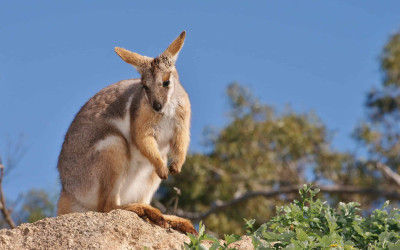
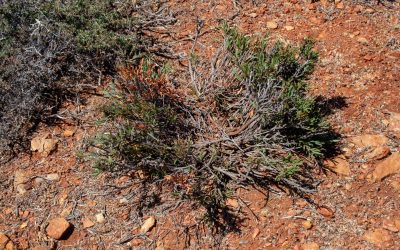
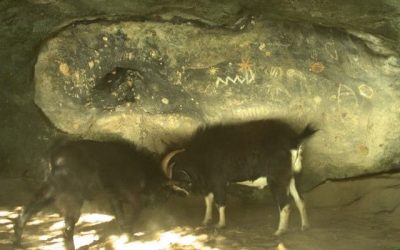
Cultural consequences
On Nantawarrina in South Australia – Australia’s first Indigenous Protected Area – Adnyamathanha rangers are fighting to protect their Country from a plauge of feral goats. They eat everything – from seedlings needed to hold the soil in place, to bush tomatoes, bush oranges and even the brilliant red Sturt desert pea that otherwise lights up the spring land. In an effort to stop the relentless damage, in 2017–2018 the rangers removed more than 9,000 goats. As of 2023, the Adnyamathanha rangers continue their dedicated efforts to manage feral goat populations and restore the land, which has significantly contributed to the recovery of native vegetation and the protection of species like the yellow-footed rock wallaby.
Feral goats have also damaged ancient Aboriginal cave art in the Whitsundays.
How do we fix this?
The good news is there is a way forward. From rugged national parks to remote islands, coordinated efforts to control feral goats have worked and led to wildlife revival.
On top of our island success stories, on the mainland, goat exclusion fencing has brought new life to fragile plant species.
In South Australia’s Flinders Ranges, the Bounceback program has proved how powerful a coordinated approach can be. Government agencies, nonprofits and landholders have worked together to push goat numbers down and keep them there. Native shrublands and rock-wallaby habitats have bounced back. Elsewhere, removing artificial water sources has helped control goat populations, leading to a slowing of erosion and the return of groundcover.
We know what works – but where feral goats are ignored or treated as a resource rather than a problem, the damage is continuing.
In some areas, full eradication is possible and urgently needed. In others, we need containment zones to stop goats spreading into new regions and degrading culturally and environmentally significant landscapes. That means stronger laws, clear responsibilities for landholders and an end to perverse incentives that encourage people to keep unmanaged goat populations on the land. We also need greater investment in Indigenous ranger programs and traditional owners who are already leading efforts to restore bush foods, protect cultural sites and, in some places, re-establish apex predators like dingoes to help keep feral herbivores in check.
FAQs
Goats arrived with the First Fleet in 1788 and were later spread by settlers and miners, and by mariners stocking islands for emergency food. Over time, farming failures and deliberate releases allowed feral herds to establish across every state and territory. Today, they occupy more than 2 million square kilometres – from the Outback to offshore islands – and continue to expand.
Goats are generalist herbivores that can eat nearly any plant, including bitter, toxic or spiny vegetation avoided by sheep and cattle. They reproduce rapidly, even while lactating, and can thrive in droughts and poor-quality habitats. They’re also excellent climbers – able to browse trees and cliffs far beyond the reach of other livestock – and tend to cluster in groups, intensifying their impact.
Feral goats damage soil, strip native vegetation, and displace wildlife. They’ve helped turn offshore islands into bare, eroding landscapes and compete with vulnerable species like the brush-tailed and yellow-footed rock-wallabies for food and shelter. Their impact is especially severe during drought and when combined with threats like foxes, rabbits and climate change.
The main barrier is money. Harvesting feral goats for meat – but mainly when prices are high – has created a financial incentive to keep them in the landscape. Policies vary across states and control programs are episodic. But goats have been successfully eradicated from over 60 islands. The Invasive Species Council is calling for tougher laws, fencing standards, dingo protection and a coordinated national strategy to ensure more success stories on the mainland.
Parkes, J, Henzell, R & Pickles, G 1996, Managing vertebrate pests: feral goats, Australian Government Publishing Service, Canberra.
Invasive Species Council 2023, Submission to the NSW Natural Resources Commission NSW invasive species management review, Invasive Species Council, Melbourne.
Luikart, G, Gielly, L, Excoffier, L, Vigne, J-D, Bouvet, J & Taberlet, P 2001, ‘The goat domestication process inferred from large-scale mitochondrial DNA analysis of wild and domestic individuals’, Proceedings of the National Academy of Sciences, vol. 98, no. 10, pp. 5927–5932.
Department of Climate Change, Energy, the Environment and Water (DCCEEW) 2023, Draft threat abatement plan for competition and land degradation by unmanaged goats, DCCEEW, Canberra, CC BY 4.0.
DCCEEW 2023, Draft background document for the threat abatement plan for competition and land degradation by unmanaged goats, DCCEEW, Canberra, CC BY 4.0.
DCCEEW 2024, National recovery plan for the brush-tailed rock-wallaby, DCCEEW, Canberra, CC BY 4.0.
Pickles, GS 1992, ‘Feral goat commercialisation: the beginning of the end of eradication?’, in JE Borrecco & RE Marsh (eds), Proceedings of the 15th Vertebrate Pest Conference, University of California, Davis, pp. 345–349.
Johnson, CN, Ritchie, EG, James, AI & Letnic, M 2021, ‘Elucidating dingo’s ecological roles: contributions from the Pelorus Island feral goat biocontrol project’, Ecological Management & Restoration, vol. 22, no. 1, pp. 5–13.
References
Parkes, J, Henzell, R & Pickles, G 1996, Managing vertebrate pests: feral goats, Australian Government Publishing Service, Canberra.
Invasive Species Council 2023, Submission to the NSW Natural Resources Commission NSW invasive species management review, Invasive Species Council, Melbourne.
Luikart, G, Gielly, L, Excoffier, L, Vigne, J-D, Bouvet, J & Taberlet, P 2001, ‘The goat domestication process inferred from large-scale mitochondrial DNA analysis of wild and domestic individuals’, Proceedings of the National Academy of Sciences, vol. 98, no. 10, pp. 5927–5932.
Department of Climate Change, Energy, the Environment and Water (DCCEEW) 2023, Draft threat abatement plan for competition and land degradation by unmanaged goats, DCCEEW, Canberra, CC BY 4.0.
DCCEEW 2023, Draft background document for the threat abatement plan for competition and land degradation by unmanaged goats, DCCEEW, Canberra, CC BY 4.0.
DCCEEW 2024, National recovery plan for the brush-tailed rock-wallaby, DCCEEW, Canberra, CC BY 4.0.
Pickles, GS 1992, ‘Feral goat commercialisation: the beginning of the end of eradication?’, in JE Borrecco & RE Marsh (eds), Proceedings of the 15th Vertebrate Pest Conference, University of California, Davis, pp. 345–349.
Johnson, CN, Ritchie, EG, James, AI & Letnic, M 2021, ‘Elucidating dingo’s ecological roles: contributions from the Pelorus Island feral goat biocontrol project’, Ecological Management & Restoration, vol. 22, no. 1, pp. 5–13.






